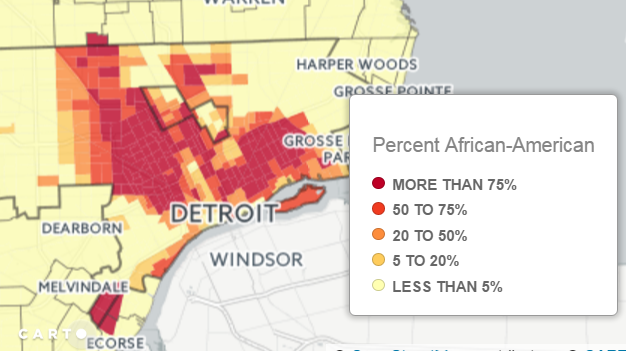The Intersection: Housing Conditions and Segregation [MAPS]
Detroit area’s racial segregation in housing has new boundaries, same discrimination.

In 1970s metro Detroit, hundreds of suburban neighborhoods had no African-American residents. Now, just a handful of Census tracts in the tri-county area can be described that way. “On that score, there is some progress,” says Mike Wilkinson, a reporter at Bridge Magazine.
But, in his article, “Black Flight to Suburbs Masks Lingering Segregation in Metro Detroit,” Wilkinson explains the contemporary dynamics of racial segregation in housing:
“We’re seeing the same patterns that existed within Detroit before 1970, before 1967 and continued beyond the borders of the city where you have this high concentration of African Americans where other African Americans are and whites where whites are,” Wilkinson said on Detroit Today with Stephen Henderson.
As part of the Detroit Journalism Cooperative’s “The Intersection” project, Wilkinson analyzed U.S. Census data which showed whites and blacks in southeast Michigan largely live in neighborhoods alongside people of the same race. He found that as African Americans leave Detroit for the suburbs – where they presumably can find better schools, safer neighborhoods, more economic development opportunities – they live in increasingly less diverse neighborhoods.
Segregation in 1970
Just after the 1967 riots, there were still large parts of west and east Detroit that were nearly all white, the vestiges of housing patterns that were cemented by federal housing policy and local real estate rules. For decades blacks had been confined to small slices of the city, creating tension that was a precursor for the anger that erupted. In 1970, 8 Mile was a real racial boundary; Warren, which bordered Detroit along that iconic road, had more than 179,000 people in 1970 but just 132 blacks. Click on an area to see how the demography of that neighborhood — here defined by census tracts — compared with areas around it.
Source: Minnesota Population Center’s National Historical Geographic Information System, Bridge Magazine.
Segregation in 2010
Although African Americans comprise 25 percent of the tri-county area, few people — black or white — live in neighborhoods that mirror the regional average. Instead, blacks are far more likely to live in majority black areas; whites in mostly white areas. Although some blacks live in almost every census tract, most are still concentrated in a handful of cities — Detroit, Southfield, Pontiac, River Rouge and Inkster. Click on an area to see how the demography of that neighborhood — here defined by census tracts — compares to areas around it.
Source: US Census, Bridge Magazine.
Could some of those patterns be explained by ongoing – and illegal – discrimination in home sales and rentals?
As executive director of the Fair Housing Center of Metropolitan Detroit, Margaret Brown is involved with investigating discrimination claims in the tri-county area. She says her group still receives hundreds of complaints annually from potential tenants or home buyers about racial discrimination.
“Racism is hundreds and hundreds of years old. It didn’t start in Detroit in the 1967 and it probably won’t end soon. Some of the things that create racism exist in this society,” Brown says. “We still have people who are told that the house is no longer available for sale even though they have the right income, they have a good credit score. All other things being measured fairly, they would be a superior buyer but they’re still told the real estate is not available.”

The Fair Housing Center’s work investigating and helping to litigate housing discrimination cases is rooted in a 1988 federal law that has some enforcement leverage, unlike previous versions dating back to the 19th century, Brown says.
Historically, the lower home ownership rates among African Americans has led to today’s “wealth gap” between the races, Wilkinson says. “Whites typically have 14 times more wealth than blacks,” he says. “So much of that is rooted in homes because a house is typically the No. 1 asset.”
Click on the audio above to hear the full conversation.
